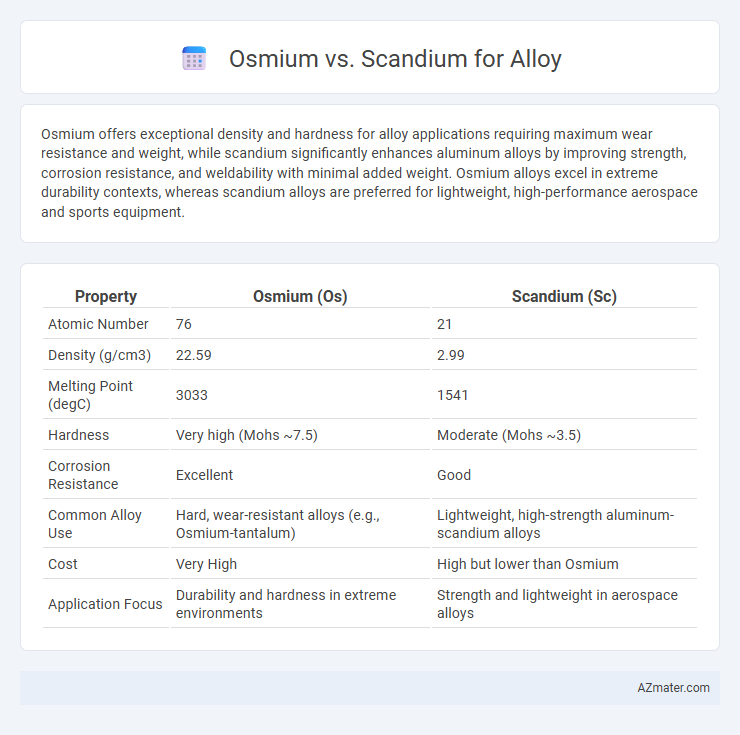Osmium offers exceptional density and hardness for alloy applications requiring maximum wear resistance and weight, while scandium significantly enhances aluminum alloys by improving strength, corrosion resistance, and weldability with minimal added weight. Osmium alloys excel in extreme durability contexts, whereas scandium alloys are preferred for lightweight, high-performance aerospace and sports equipment.
Table of Comparison
| Property | Osmium (Os) | Scandium (Sc) |
|---|---|---|
| Atomic Number | 76 | 21 |
| Density (g/cm3) | 22.59 | 2.99 |
| Melting Point (degC) | 3033 | 1541 |
| Hardness | Very high (Mohs ~7.5) | Moderate (Mohs ~3.5) |
| Corrosion Resistance | Excellent | Good |
| Common Alloy Use | Hard, wear-resistant alloys (e.g., Osmium-tantalum) | Lightweight, high-strength aluminum-scandium alloys |
| Cost | Very High | High but lower than Osmium |
| Application Focus | Durability and hardness in extreme environments | Strength and lightweight in aerospace alloys |
Introduction to Osmium and Scandium Alloys
Osmium alloys are renowned for their exceptional density, hardness, and corrosion resistance, making them ideal for applications requiring extreme durability and wear resistance in industrial and scientific instruments. Scandium alloys, particularly aluminum-scandium alloys, enhance strength, weldability, and corrosion resistance while maintaining lightweight characteristics, prominently used in aerospace and sports equipment. The unique properties of osmium alloys offer superior hardness and stability, whereas scandium alloys provide improved mechanical performance and reduced weight, highlighting their distinctive roles in advanced materials engineering.
Elemental Properties: Osmium vs Scandium
Osmium exhibits high density (22.59 g/cm3) and exceptional hardness, making it ideal for wear-resistant alloys, while scandium offers low density (2.99 g/cm3) and excellent strength-enhancing properties when alloyed, especially in aluminum-based materials. Osmium's melting point is significantly higher (3045degC) compared to scandium's (1541degC), affecting processing and application temperatures. The limited ductility of osmium contrasts with scandium's ability to improve alloy toughness and corrosion resistance in aerospace components.
Abundance and Availability in Nature
Osmium ranks among the rarest and densest elements, with an average abundance of about 0.001 ppm in the Earth's crust, making it extremely scarce and costly for alloy production. Scandium occurs more frequently, at approximately 22 ppm, primarily extracted from rare earth minerals and certain ores, offering greater availability for alloy applications. The limited natural supply of osmium restricts its widespread use, while scandium's relative abundance supports more extensive alloy manufacturing.
Alloying Behavior and Compatibility
Osmium exhibits exceptional hardness and density, making it suitable for high-strength, wear-resistant alloys, especially in applications requiring corrosion resistance and stability at extreme temperatures. Scandium enhances aluminum alloys by significantly improving strength, weldability, and grain refinement without compromising lightweight properties, ideal for aerospace structures. While osmium forms complex intermetallic compounds that can increase brittleness, scandium tends to improve ductility and alloy homogeneity, making it more compatible with aluminum-based systems for structural applications.
Mechanical Strength and Durability
Osmium alloys exhibit exceptional mechanical strength and durability due to osmium's high density and hardness, making them ideal for applications requiring extreme wear resistance and stability under high stress. Scandium alloys, while lighter, offer superior corrosion resistance and enhanced tensile strength, particularly when used in aluminum matrices, increasing fatigue life and toughness. Osmium's superior hardness surpasses scandium's in high-strength scenarios, but scandium alloys provide a better strength-to-weight ratio essential for aerospace and lightweight structural components.
Corrosion Resistance: A Comparative Analysis
Osmium exhibits exceptional corrosion resistance due to its dense, stable oxide layer, making it highly durable in aggressive chemical environments. Scandium, while less corrosion-resistant than osmium, enhances the corrosion resistance of aluminum alloys by refining grain structure and reducing oxidation. In alloy applications requiring superior corrosion resistance, osmium offers a more robust and long-lasting protective advantage compared to scandium.
Industrial and Technological Applications
Osmium, with its exceptional density, hardness, and corrosion resistance, is primarily used in high-wear industrial components such as electrical contacts, fountain pen nibs, and instrument pivots, enhancing durability in extreme environments. Scandium, valued for its strength-to-weight ratio and ability to refine aluminum grain structures, is extensively utilized in aerospace alloys, sporting equipment, and automotive manufacturing to improve performance and reduce weight. The integration of osmium alloys is limited by cost and toxicity, while scandium alloys offer scalable benefits in advanced technology applications due to their lightweight and mechanical properties.
Cost Implications of Using Osmium and Scandium
Osmium alloys typically incur high costs due to osmium's rarity and complex extraction process, making them less feasible for large-scale applications. In contrast, scandium alloys offer a more cost-effective solution with moderate pricing influenced by scandium's limited but growing availability in industrial sectors. The decision between osmium and scandium alloys hinges largely on budget constraints and the specific material properties required for the application.
Environmental and Health Considerations
Osmium, known for its high density and hardness, poses significant environmental and health risks due to its toxicity and the release of osmium tetroxide, which is highly volatile and hazardous. Scandium alloys, often used to enhance aluminum properties, offer a comparatively safer profile with lower toxicity and minimal environmental impact during processing and disposal. Selecting scandium over osmium in alloys reduces occupational exposure to harmful substances and contributes to more sustainable manufacturing practices.
Future Prospects for Osmium and Scandium Alloys
Osmium alloys exhibit exceptional hardness, high density, and excellent corrosion resistance, making them ideal for specialized applications in aerospace and electronics where durability and weight are critical. Scandium alloys, known for their light weight and strength enhancement, are increasingly used in the aerospace and automotive industries due to their ability to improve aluminum alloy performance and reduce fuel consumption. Future advancements in osmium-alloy processing and scandium alloy recycling are expected to drive broader adoption across high-performance and sustainable material sectors.

Infographic: Osmium vs Scandium for Alloy
 azmater.com
azmater.com